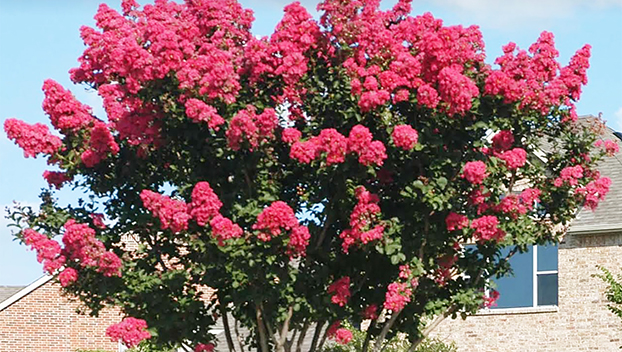TEXAS CERTIFIED EXPERT GARDENER — See how to reverse Crepe Myrtles pruning mistakes
Published 12:02 am Wednesday, February 7, 2024

- Crepe myrtles require minimal pruning and provide stunning curb appeal when proper pruning techniques are utilized. Removing the tree’s canopy each season as a pruning technique creates gnarled lobes where weak sprouts will grow that cannot support the weight of flowers. (greenthumbsgarden.com)
|
Getting your Trinity Audio player ready...
|
Over the past couple of weeks fellow gardeners have asked that I explain how to prune crepe myrtles, as I often complain (to anyone that will listen) about “neighbors following neighbors” poor pruning behaviors.
One neighbor will drastically prune a crepe myrtle, often using a chain saw cutting each trunk level horizontally; this pruning technique quite literally “butchers” the shrub (small tree) and is extremely destructive to the plant.
Gardeners, just because your neighbors do something, such as ‘massacring’ their myrtles doesn’t mean you have too! I’m on a mission to eradicate the three M’s: Myrtle Murder Madness from SETX. It’s truly disappointing to see crepe myrtles reduced to hideous stumps, as too many SETX neighborhoods harbor ‘glaring eyesores’ (examples of crepe myrtles severely scarred by incorrect pruning).
Are you guilty of committing a crepe myrtle atrocity?
If in the past you demonstrated bad crepe myrtle pruning behaviors, all may not be lost, though it depends upon the amount of damage inflicted by improper pruning. Crepe myrtle pruning mistakes can be corrected over time.
Let me begin by stating crepe myrtles require very little pruning to maintain their natural structure. Strong, upright branches support the heavy weight of flowers, while the smooth, multi-trunked trees center remains open.
Ruthlessly cutting the tree and removing the entire canopy does not allow the tree to gracefully mature, instead it becomes gnarled & knotted with spindly, wispy branches (which resemble Medusa) incapable of holding flowers upright.
The pruning “goal” is well-spaced main trunks to allow for beautiful bark to form, remove crossed trunks, permitting sunlight penetration while promoting air circulation.
THINK before CUTTING trunks. Have a plan in place beforehand and know exactly what you want to accomplish before making the first cut. Learn from my experience, always be conservative when cutting! February is the best month to prune crepe myrtles, as the trees are leafless.
Required Pruning Tools
- Bypass hand pruner for twigs & branches less than ½-inch diameter.
- Loppers to remove branches ½ to 1½ inches in diameter.
- Pruning saw to remove branches larger than 1½ inches in diameter.
- Do Not use a chain saw, as it can severely the tree!
Pruning-The Right Way
Never reduce a crepe myrtles height, it leads to the “Medusa” effect damaging and disfiguring the tree.
Don’t utilize the “chainsaw haircut” pruning approach which ensures a plethora of willow-like sprouts will grow out from each “stump” that are too weak to support flowers, forcing the branches to bend towards the ground.
Avoid over-pruning, and pruning should begin at the base working upwards:
- Crepe myrtles are multi-trunked trees, limit the number of trunks to tame the spread if necessary. Limit the tree to 3-7 trunks, cutting back to a larger trunk branch as close to the soil (don’t leave stubs) as possible.
- “Suckers be gone” remove them constantly, as they grow around the base and if left in place (unchecked) will become trunks.
- Remove branches extending below the 5 foot mark on each trunk, to keep the “tree-like” structure. Larger trees will require removing branches higher, 7 to 9 foot mark. Remember to have a plan before removing limbs!
- Lastly remove upper branches growing inward towards the center. Crossed and dead branches need to be removed. Cut above an outward facing branch to the branch collar where the limb connects to the trunk.
“Reversing” Pruning Mistakes
If a tree has been repeatedly “abused” in past years by removing its canopy near ground level, there is only one solution which is to cut the tree down to the ground.
Crepe myrtles are fast growing trees and the following winter identify 5 or 7 well-spaced trunks, then remove the remaining trunks to ground level. An attractive tree will re-grow within five years.
Perhaps you didn’t follow your neighbor’s lead “completely” and decided to leave a longer tree trunk by pruning each of the main branches to similar heights. Remove the “gnarled” knobs and within a few weeks numerous shoots will grow from the stumps.
Remove all but a couple of them, which will continue to grow. Continue removing new sprouts from the stubs each spring for several years.
Train the selected sprouts to grow upward & outward as they will become the main tree trunks. Past pruning mistakes will “eventually” disappear (3 to 5 years) providing you with a non-medusa-like tree!
Let’s go out and grow ourselves a greener, more sustainable world, one plant at a time.
Send Certified Texas Expert Gardener John Green your questions and please continue sending comments to jongreene57@gmail.com.





